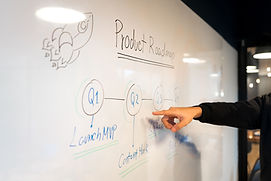
The Context
Rapid Change and Growing Pains
By late 2018, Wayfair's Operations Product Innovation (OPI) organization had scaled considerably from a scrappy product organization of ~40 PMs based in Boston to a global organization of over 250 PMs spanning the U.S. and Europe.
Unfortunately, the department's onboarding program had not kept pace. Reference materials were outdated and managers had become too busy to devote time to getting new employees up to speed. As a result, incoming PMs experienced considerable confusion around how to navigate their new roles, teams, department, and organization.
The Challenge
Rethink PM Onboarding

In early 2019, I was brought in by Wayfair product leaders to rethink OPI's approach to onboarding. Partnering with a cadre of senior PM subject matter experts, we set out to redesign the onboarding experience for PMs from one that left them wanting to one that would set them up for success within their first few 90 days at Wayfair.
The Redesign
What We Did + How We Did It

Over the course of 6 months, I led the build and rollout of a new onboarding experience for Wayfair PMs in OPI. Work unfolded iteratively over multiple phases.
I. Analyze
Shedding Light on the Real Problem
The first few months of the project involved gathering information on the issues facing recent PM hires to ensure we would be building the right thing.
This phase involved:
-
A survey of all PMs to assess their experience being onboarded to identify key pain points/challenges
-
Interviews with managers on what new PMs needed to know and do within their first 90 days to be successful
-
An audit of the current onboarding program to identify strengths and weaknesses
-
Development of a needs analysis report to document the problem and recommend a potential solution
-
Presentation of findings to senior leaders to receive feedback and get buy-in for the changes
My analysis revealed that PMs were dissatisfied with the current 1-month onboarding program and that a shorter, more centralized onboarding experience coupled with resources and job aids would be a more suitable solution.


II. Design
Sketching Out the Solution
Upon receiving sign-off from OPI product leaders on designing a new program, the next month involved fleshing out the program's goals and designing a strategy to meet them.
This phase involved:
-
Recruitment of subject matter experts and program sponsors to guide design, development, and rollout
-
Articulation of learning objectives for the new program
-
Creation of an assessment and evaluation strategy
-
Experience mapping the new onboarding journey, including determining the most appropriate content, activities, resources, and technologies
-
Testing of initial design ideas with recent hires




III. Build
Standing Up the Program
After validating the experience design with learners and managers, we then developed the materials necessary to make the experience a reality.
This phase involved:
-
Working with SMEs to develop effective and engaging content
-
Review and revision of content to ensure clarity and alignment with learning objectives
-
Development of a new hire "checklist" and "roadmap" to scaffold employee learning over their first 30, 60, and 90 days.
-
Development of a new hire virtual "backpack" of key resources, tools, and contacts for them during their first 90 days.
-
Development of a "scavenger hunt" to test new hires' ability to navigate the organization physically and digitally
-
Development of onboarding resources for new hiring managers.
-
Testing of content and activities with learners and managers




IV. Deliver
Rolling Out the New Program
The revamped program was delivered to 12 new hires for the first time in the Spring of 2019. On my end, delivery involved:
-
Bi-weekly facilitation of "Welcome to OPI" onboarding session for incoming new hires
-
Creation of facilitator guides for SMEs to facilitate the other six sessions
-
Fielding of new hire questions and feedback in Slack for the entirety of their first 90 days


V. Evaluate + Improve
Measuring Impact and Making Improvements
Of course, the most critical work involved gathering data from participants to assess their satisfaction with the program and its impact on their experience during their first 90s days.
This phase involved:
-
Dissemination of evaluation surveys to assess participant experience immediately after the program, 30 days later, and 90 days later
-
Interviews with managers to determine the impact of the program on employees learning curves during their first 3 months
-
Regular revision of content and structure of the program to reflect new hire and manager feedback and organizational changes



Outcome
Smarter Onboarding, Faster Impact
The new 2-day intensive program was delivered to 2-12 incoming PMs every other week for 12 months until the OPI department was merged with another department.
Learners, managers, and leaders were generally pleased with the results. See below for some indicators of success.
Results
200+
New PMs Onboarded Successfully
Over 200 PMs were onboarded over the life of the program, with only two leaving before their first 90 days.
87%
Learner Satisfaction
87% of learners said they were "Satisfied" or "Very satisfied" with their onboarding experience 90 days after the program.
~1/3
Less Time Required from Managers
Managers estimated that they spent 1/3 less time answering new employee questions than they had previously.
What Stakeholders Had to Say

"I enjoyed the 2 days of sessions during my first week. I felt welcomed, and it was great to meet other new PMs."
Wafair PM

"The two PMs I have brought on are far less confused than others I've hired. In fact, they are teaching me some things about the department I didn't even know."
Wayfair Hiring Manager

"This new program is much more effective than the previous one we threw together. It's also helped us feel more like a department."

